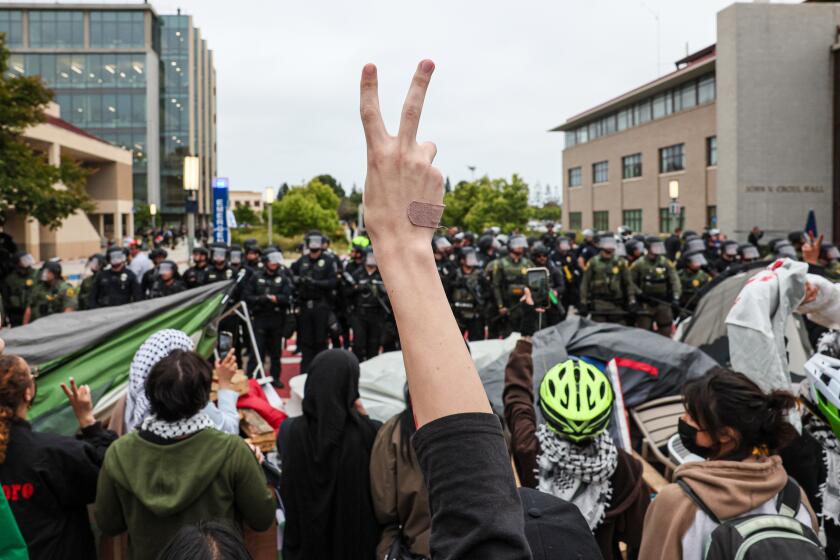How teaching taught professor Lopez to appreciate teachers — and students
I can’t begin to recall how many classrooms I’ve visited in more than 40 years as a journalist. Dozens for sure. More than a hundred, perhaps. Everything from grade school to graduate school.
But my knees wobbled when I was offered a chance to teach an evening class at Cal State L.A.
Why?
Because visiting a class to answer a few questions and offer a few tips — never to return again — isn’t that big of a challenge. But a teacher has to actually teach.
And I didn’t know how to do that, even though I was pretty familiar with the subject: How to find and tell stories.
Still, I took a leap.
As someone who spouts off now and then about education, it couldn’t hurt to do a little honest homework.
And I did it because I’m a graduate of the Cal State system (San Jose State, 1975), and I believe in it.
The mission is the same as ever — offer a quality education at a reasonable price — although tuition has spiked in recent times. Every year, tens of thousands of graduates, many from humble means, help drive California’s economy when they go into healthcare, business, technology, social sciences, engineering, law enforcement, communications and teaching.
So I asked teachers for some advice, and David Olsen, chairman of Cal State L.A.’s communications department, helped me put together a syllabus that offered something to aspiring journalists, TV/film majors and students interested in polishing their writing skills.
And then on a Monday night in January, I found myself standing before 20 upperclassmen and grad students, all of whom looked at me expectantly.
It was the first of 10 classes in the winter quarter, each one from 6:10 to 10 p.m., which struck me — as I passed out my syllabus — as an eternity. That’s a lot of teaching for a flat-footed rookie, and I loosened my collar, feeling the heat.
What if I ran out of things to say?
My students, I soon learned, do a lot of juggling. Most of them work, some of them full time, and care for families. They save money, take classes when they can afford them and keep pursuing the dream of a college degree, even if it takes six or eight or 10 years to earn the paper.
See more of our top stories on Facebook >>
I owed them something, and I made it through the first session encouraged not so much by my performance but by my students’ engagement. With the exception of one young man who may or may not have been awake — I couldn’t tell for sure, and he later dropped the class — they listened, and spoke up, and we began to get to know each other through a shared love of words.
I followed all the advice I’d gotten from real teachers: Split the students into groups, have them read each other’s work, find ways to spark class discussions and bring in guest speakers.
My appreciation of teachers is now greater than ever.
Two students sitting next to each other might have vastly different skill levels, and you’ve got to find a way to address their very different needs.
Meeting one-on-one during office hours helps. But I’ve come away from this experience even more convinced that packing 30 or 40-plus students into a classroom — the norm in public K-12 schools — is insane. It’s a burden on teachers and a disservice to students.
The 10-week course ended just as I was getting to know my students, and realizing that while I may have helped them find ways to shape stories, they were teaching me things about the city I cover.
Daniel Noriega wrote about his grandfather riding through East Los Angeles on a bicycle, collecting discarded toys for a backyard shrine, believing that each toy represents “the lost spirit of a child.”
Noriega wrote that his mother took this idea to the next level, caring for troubled, wayward children. When one later died, she paid for his coffin, and then “La Mama de East L.A.” started a nonprofit to buy coffins for other families that couldn’t afford proper burials for loved ones.
Brandon Winfield — a full-time student and laborer — would often hustle into class a few minutes late, just off work from laying underground wire. His term paper was an account of the culture shock his African American family endured when his mother, determined to keep her kids safe, shepherded her brood out of South-Central and into the San Gabriel Valley.
Former teacher Claudia Mercado took care of her parents, worked several jobs and commuted 30 miles to school in pursuit of her master’s. She wrote a poetry-infused tribute to a Northeast Los Angeles women’s activism and art collective — Mujeres de Maiz — where kindred spirits have connected through stories of personal struggle and cultural pride.
Gus Ugalde Jr. — my oldest student, in his 50s — told me how upset he was about the demolition of the Sixth Street bridge in February, because it held special memories of his youth in Boyle Heights. Then tell me a story, I told him. And he did, writing that in his memories, the days are long and never turn to night, and he is riding his bike across the bridge or crossing it on foot, holding his grandmother’s hand.
“I can still hear the sound of my corduroy pants rubbing against each other like that of clothes being scrubbed on an old-fashioned washboard. It was perpetual summer. I could still see grandma holding her parasol overhead to shield herself from the unyielding rays of the sun.”
A new crop of students is coming in now for the start of the spring quarter, and I feel a little more confident this time around.
We’ll write, we’ll talk, we’ll get to know each other. Maybe I’ll teach them a thing or two and maybe they’ll return the favor.
ALSO
Why so many voters are drawn to Donald Trump
The Coastal Commission is learning the meaning of sorry-not sorry
Trump circus rolls into Phoenix in a taste of what’s in store for California
More to Read
Sign up for Essential California
The most important California stories and recommendations in your inbox every morning.
You may occasionally receive promotional content from the Los Angeles Times.











